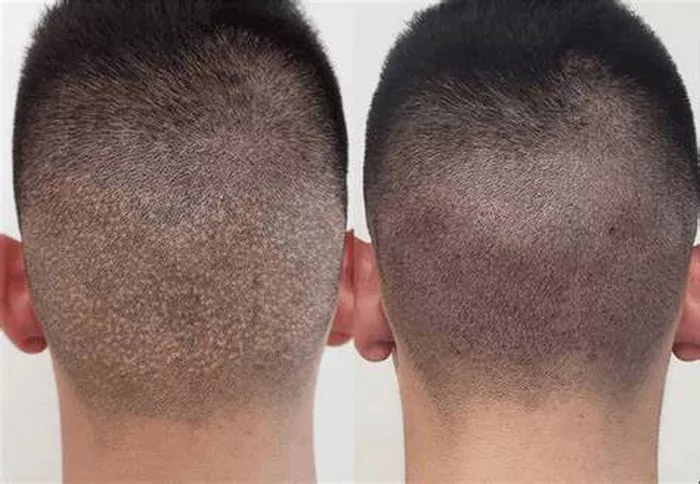Follicular Unit Extraction (FUE) is a popular hair transplant technique known for its minimal scarring compared to traditional methods. However, understanding the longevity and visibility of FUE scars is crucial for individuals considering this procedure. This article delves into the nature of FUE scars, factors influencing their duration, and strategies to minimize their appearance.
Understanding FUE Scars
FUE involves extracting individual hair follicles from a donor area, usually at the back or sides of the scalp, and transplanting them to areas with thinning or no hair. This process results in tiny, circular scars at the extraction sites.
Characteristics of FUE Scars
Size and Shape: FUE scars are typically 0.8 to 1.0 millimeters in diameter, appearing as small, round dots.
Color: Initially, they may be red or pink, but they usually fade to a color that matches the surrounding skin over time.
Visibility: The scars are generally less noticeable due to their small size and the distribution of extraction sites.
Factors Influencing the Duration of FUE Scars
The longevity and visibility of FUE scars depend on several factors, including individual healing characteristics, the surgeon’s skill, and post-operative care.
Individual Healing Characteristics
Skin Type: People with lighter skin tones may experience less noticeable scarring, while those with darker skin may have more pronounced scars.
Age: Younger individuals tend to heal faster and may have less visible scarring compared to older individuals.
Genetics: Some people are genetically predisposed to develop more noticeable scars.
Surgeon’s Skill and Technique
Precision: An experienced surgeon can perform FUE with precision, resulting in smaller and less noticeable scars.
Punch Size: Smaller punches used during extraction reduce the size of the scars.
Spacing: Proper spacing of extraction sites can minimize the overall visibility of scars.
Post-Operative Care
Proper Wound Care: Following the surgeon’s instructions for wound care can significantly impact the healing process.
Avoiding Sun Exposure: Protecting the scalp from sun exposure can prevent scars from becoming darker and more noticeable.
Nutrition: A diet rich in vitamins and minerals, particularly Vitamin C and zinc, can promote faster healing and reduce scarring.
Phases of Scar Healing
FUE scars undergo several phases of healing, each impacting their visibility.
Inflammatory Phase (0-7 Days)
Immediately after the procedure, the scalp may be red and swollen. This phase involves the body’s initial response to injury, characterized by inflammation and the formation of a protective scab.
Proliferative Phase (1-3 Weeks)
During this phase, new tissue forms as the body begins to repair the extraction sites. The scars may still be pink or red and slightly raised.
Maturation Phase (3 Weeks to 1 Year)
Over the next several months, the scars gradually fade and flatten. Collagen remodeling occurs, and the scars blend more seamlessly with the surrounding skin.
See Also: How Much Does Hair Transplant Cost in the Philippines?
Long-Term Scar Appearance
6 Months Post-Procedure
By six months, most FUE scars have significantly faded. They are often barely noticeable unless the hair is closely shaved. The scars typically match the surrounding skin color, reducing their visibility.
1 Year and Beyond
After a year, the scars reach their final appearance. For many individuals, the scars are virtually invisible, especially when the hair in the donor area grows back. The tiny dot scars blend with the natural texture and color of the scalp.
Scar Minimization Techniques
Several techniques can help minimize the appearance of FUE scars, enhancing the overall aesthetic outcome of the procedure.
Laser Therapy
Laser treatments, such as fractional CO2 lasers, can improve the texture and color of scars. These treatments promote collagen production and skin resurfacing, making scars less noticeable.
Microneedling
Microneedling involves creating tiny punctures in the skin to stimulate collagen production. This can improve the appearance of scars by enhancing skin texture and reducing discoloration.
Topical Treatments
Silicone Gel: Applying silicone gel to scars can help flatten and fade them over time.
Vitamin E: Topical Vitamin E may promote healing and reduce scar visibility.
Camouflage Techniques
For individuals concerned about scar visibility, several camouflage techniques can help.
Scalp Micropigmentation (SMP)
SMP involves tattooing tiny dots on the scalp to mimic the appearance of hair follicles. This can effectively conceal FUE scars, especially when combined with a closely shaved hairstyle.
Hair Styling
Keeping the hair slightly longer in the donor area can naturally conceal the tiny dot scars. Strategic haircuts and styles can make scars virtually undetectable.
Potential Complications Affecting Scar Appearance
While FUE is generally a safe procedure, certain complications can impact the appearance of scars.
Infection
Infection at the extraction sites can lead to increased inflammation and more noticeable scarring. Proper post-operative care and following the surgeon’s instructions can minimize this risk.
Keloid Formation
Some individuals are prone to keloid formation, where scars become raised and extend beyond the original wound. This is more common in people with darker skin tones and a genetic predisposition to keloids.
Hypopigmentation
Hypopigmentation, or lightening of the skin at the scar site, can occur, making scars more noticeable. This is more likely if the extraction sites are exposed to sunlight during the healing process.
Psychological Impact of Scarring
The psychological impact of scarring can vary from person to person. Understanding the emotional aspects can help individuals manage their expectations and concerns.
Self-Esteem and Confidence
Visible scars can impact self-esteem and confidence, especially if the individual feels self-conscious about their appearance. Counseling or support groups can help individuals cope with these feelings.
Managing Expectations
Having realistic expectations about the outcome of FUE and the appearance of scars is crucial. Discussing potential scarring with the surgeon beforehand can help set realistic goals and reduce anxiety.
Conclusion
FUE scars are typically small, round, and less noticeable than scars from traditional hair transplant methods. Their visibility and duration depend on various factors, including individual healing characteristics, the surgeon’s skill, and post-operative care. With proper care and scar minimization techniques, most FUE scars become barely noticeable over time. Understanding the healing process and managing expectations can help individuals achieve the best possible outcome from their FUE procedure.


